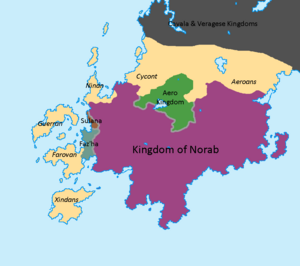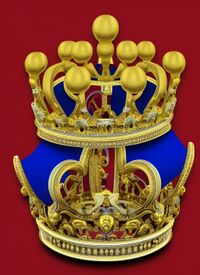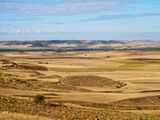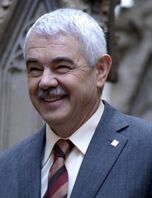Paqueonia: Difference between revisions
Philimania (talk | contribs) |
Philimania (talk | contribs) |
||
| (7 intermediate revisions by the same user not shown) | |||
| Line 74: | Line 74: | ||
|drives_on = right | |drives_on = right | ||
|cctld = .pa | |cctld = .pa | ||
|calling_code = | |calling_code = +3 | ||
|p1 = Paqueon Empire | |p1 = Paqueon Empire | ||
|flag_p1 = Paqueonia Flag.png | |flag_p1 = Paqueonia Flag.png | ||
| Line 165: | Line 165: | ||
During the late 15th century, two rebellions occurred, first a Mutamni uprising known as the [[Heshiso Uprising of 1458]] from 1458 to 1465, and a Terranist one called the [[Inteminan Rebellion]] from 1471 to 1475. | During the late 15th century, two rebellions occurred, first a Mutamni uprising known as the [[Heshiso Uprising of 1458]] from 1458 to 1465, and a Terranist one called the [[Inteminan Rebellion]] from 1471 to 1475. | ||
== Paqueon Empire == | === Paqueon Empire === | ||
Although sailing was quite prominent in Paqueon culture before the 16th century, it was bolstered with the invention of the {{wp|carrack|Enbarck}} by [[Paloa|Palon]] engineer [[Quim Vaza]]. | |||
[[File:Kuno Schenck.png|250px|thumb|Depiction of [[Kuno Schenck]] landing in the Domicas and being greeted by the natives.]] | |||
Although stories and rumours of a landmass to the west of [[Oranath]] and [[Naphtora]] persisted throughout the eras they were never confirmed and remained widely a myth throughout the [[Ancient Era|Ancient]] to [[Middle Era]]s. However, on 13 Pusper 1513 Paqueon explorer, [[Kuno Schenck]] embarked on a voyage funded by the Paqueon monarch with a fleet of 4 ships. 41 days later on the 24 Kunnen Schenck made landfall on the island of X in modern-day [[Flakony]]. Schenck's first voyage across the [[Ingentric Ocean]] proved the existence of the Domicas, beginning Oranish exploration and conquest of the region with the first colony set up by Paqueonia in 1515 known as [[New Castelano]] in what is at present the nation of [[La Munda]]. The founding of the first colony is regarded by many people as the beginning of the [[Paqueon Empire]]. | |||
In [[Flonesia]], Paqueon explorer [[Mateo Lago]] landed in southern Aralona in Pulungana of 1530, claiming the territory of what is now the city of [[Damien]] although no attempts to settle the area were made until 1542. Colonisation in the Domicas was marked by the expansion into central Domica and numerous conflicts with the [[Atontec Empire]] and Paloa, the most notable example being the [[Colonian War]] (1542-1547) against the Atontecs and the [[Poder War]] (1561-1562). Meanwhile, in Aralona, the [[Flonesian Scramble]] culminated in the outbreak of the [[Flonesian War]] resulting in Paqueonia and Seronia-Sotha's seizing of Palon and Omaran colonies in Aralona by its end in 1586. | |||
The late 16th century and the early 17th century are characterised by the colonisation of modern-day [[Wavantine]] and [[Lavinia]] which ended with the exploration and the complete colonisation of South Domica by the beginning of the 1640s. Throughout the 17th and 18th centuries, Paqueonia proved to be one of the leading world powers, a position reinforced by trade and wealth from colonial possessions and became Gentu's leading maritime power. This period saw the [[War of 1602]] (1602-1615) between Paqueonia and Neragon throughout their holdings in Gentu, the [[War of Paqueon Terranity]] (1620-1625) between the Paqueon Altenic and Paxist churches, the [[First Atontec War]] (1654-1666) in South Domica, the [[First Northern War]] (1710-1716) in northern Hesterath, and the [[Lavinian Revolt]] (1727-1729) carried out by the Lavinians in South Domica. | |||
During the mid-18th century, with the rise of the [[Slave Network]], Paqueonia established multiple slave routes across western Naphtora, beginning Paqueonia's interest in the Naphtoran coast. From 1750 to 1812, Paqueonia invaded and conquered numerous Naphtoran kingdoms along the west Naphtoran coast to secure their supply of slaves. This culminated in the [[West Naphtoran War]] against Paloa, a competitor in the region in 1759. They won the war after seven years of conflict, resulting in the establishment of the Colonies of [[Colony of Karaterra|Karaterra]] and [[Colony of New Parkowo|New Parkowo]] in western Naphtora, two port cities built specifically to house slaves. | |||
In 1748, the [[Second Atontec War]] began in South Domica between the Atontecs and the [[South Atontec Republic]]. Taking advantage of this, the Paqueon South Domican colonial government in [[Lavinia]] and [[La Munda]] moved their forces into the Atontec and even signed the [[Furmdura Agreement]] (1749) with the Southern Atontecs, establishing an alliance between the nations. Raging from 1748 to 1764, it is regarded by many historians as the most devastating and deadliest war in South Domica. By its end, it had claimed a total of roughly 7 million lives on both sides and concluded with the climactic [[Battle of El Rojo]] where the La Munda Paqueon army was routed from northern Atontec territories. This was seen by many as the beginning of the decline of the Paqueon Empire and the first major defeat for Paqueonia since the Hesserlic Civil War in the 1410s. | |||
With the dawn of the [[Industrial Revolution (Gentu)|Industrial Revolution]], factories sprung up throughout the Paqueon countryside resulting in the growth of villages into large cities such as [[Haoẽnsia]], [[Brunada]], [[Ferron City|Ferron]] and [[Auesca]]. During this period, the population of Paqueonia rose from 9 million in 1760 to nearly double that at 17 million by the mid-19th century. | |||
During the [[Cavalan Revolution]] and later the [[Great Coalition War]], the [[Legión Extranjera Paqueaño|Paqueon Foreign Legion]] was sent to aid the [[Veragese Collective]] against the Cavalans, however, they were mostly destroyed during the [[Battle of Ôter-Colline]] in 1819. Meanwhile, in South Domica, the [[Amplan Wars]] began with numerous uprisings occurring, the most famous of which was [[Ureña's Revolution]] in 1820 in Lavinia led by revolutionary [[Thiago Ureña]], establishing the shortlived [[Urenian Republic]] in Phupu that year before it subsequently dissolved into Lavinia and [[Adinaza]] just two months later. Other revolutions also occurred in [[Mavantine]], [[Central Domica]], the [[Nortian Islands]], and [[La Munda]]. | |||
''TBA'' | ''TBA'' | ||
| Line 390: | Line 408: | ||
[[Category:Paqueonia]] | [[Category:Paqueonia]] | ||
[[Category:Countries in Gentu]] | [[Category:Countries in Gentu]] | ||
[[Category:Countries]] | [[Category:Countries]] | ||
Latest revision as of 08:08, 2 September 2023
This article is a work in progress. Any information here may not be final as changes are often made to make way for improvements or expansion of lore-wise information about Gentu. Please comment on this article's talk page to share your input, comments and questions. Note: To contribute to this article, contact User:Philimania. |
Kingdom of Paqueonia Reino de Paqueañes (Hestandan) | |||||||
|---|---|---|---|---|---|---|---|
| Motto: "Dios salve a nuestro rey" "God save our king" | |||||||
| Anthem: X Royal anthem: X | |||||||
 Location of Paqueonia (Green) in Oranland (Dark Grey) | |||||||
| Capital | Castelano | ||||||
| Largest city | Hidalgo | ||||||
| Official languages | Hestandan | ||||||
| Ethnic groups (2000) | 89.6% Hestandan 8.9% Cavalan 1.5% Others | ||||||
| Religion (1999) | 47.5% Hafan 41.8% Terranity 5.2% No religion 5.5 Others | ||||||
| Demonym(s) | Paqueon | ||||||
| Government | Unitary absolute monarchy | ||||||
• Monarch | Gerado II | ||||||
| Fidel-Osvaldo | |||||||
| Carlos Avena | |||||||
| Legislature | National Council | ||||||
| Formation | |||||||
| 17 Kunnen 1059–24 Okjatab 1092 | |||||||
| 14 Marto 1355 | |||||||
| 1 Enero 1543 | |||||||
| 30 Tebax 1945 | |||||||
| Area | |||||||
• Total | 616,777 km2 (238,139 sq mi) (X) | ||||||
• Water (%) | 0.52 | ||||||
| Population | |||||||
• 2000 census | |||||||
• Density | 94.8/km2 (245.5/sq mi) (X) | ||||||
| GDP (PPP) | 1999 estimate | ||||||
• Total | |||||||
• Per capita | |||||||
| GDP (nominal) | 1999 estimate | ||||||
• Total | |||||||
• Per capita | |||||||
| Gini (2000) | low (X) | ||||||
| HDI (1998) | very high (X) | ||||||
| Currency | Paqueon Karat (₭) (PAK) | ||||||
| Time zone | MTS-9 (West Oranland Time) | ||||||
| Date format | yyyy-mm-dd CE | ||||||
| Driving side | right | ||||||
| Calling code | +3 | ||||||
| Internet TLD | .pa | ||||||
| |||||||
Paqueonia (Hestandan: Paqueañes) or the Kingdom of Paqueonia, is a country in southwestern Oranland with overseas territories in the Domicas and the North Nullaric Ocean. The country is bordered by Cavala in the north, Paloa to the west, and the Zestoric Sea to the south and east.
With an area of 616,777 km2 (238,139 sq mi), Paqueonia is the X-largest country in Oranland and, with a stable population of 58.5 million, the X-most populous Oranish nation. Paqueonia's capital city is Castelano while the largest city is Hidalgo; other major urban areas include Duran, Haoẽnsia, Brunada, Auesca, and Aarono.
The Hesterlon Peninsula was populated by early humans c. 1.5 million years ago. Modern humans first arrived in Hesterlon, from the east about 60,000 years ago. The best known artefacts of the early humans are the famous paintings in the Ultima caves of X which were created from 60,000 to 20,000 BP. The largest groups inhabiting Paqueonia before Calidum colonisation were the Veragese people, or more specifically, the Aeroans, Amossans, and Norravans. The first evidence of Calidum settlements appeared around 2300 BCE. However, several cities and trading posts were founded along the coast by the Calidum; one of the most famous being Hidalgo itself around the late 21st century BCE. In 1143 BCE, a war between the Amossans and the Calidum Empire was sparked. By 1138, Calidum forces had been pushed back to Hidalgo where the city was sieged and after which it was abandoned. The region would stay isolated from the rest of the Zestoric until the late 4th century BCE when the Pylosan Empire colonized Paqueonia. From the late 4th century until the demise of the Pylosan Empire after the 2nd Zestoric War in 1 CE, Pylosan colonies in Paqueonia faced numerous attacks brought by Amossan and later Norravan tribes. After the 2nd Zestoric War ended in 1 CE, Pylosan colonies especially those on the Hesterlon Peninsula were assimilated into the Alarican Empire. Following multiple conquests and campaigns during the 1st century and early 2nd century, Alarico was able to assimilate the Hesterlon Peninsula after destroying a united Cycont army at the Battle of Arouthinium in 129.
A colonial regime was installed in what is now Paqueonia and Paloa soon after the defeat of the Cycont army in 129. They retained control of it for over four centuries. During the late 5th century CE, rebellions became more frequent in the region. According to the Contemporary historian Oppius, following a successful rebellion which occurred in Paloa c. 466, the Hestando people rebelled against Alarico in 470 CE eventually uprooting the colonial regime over Paqueonia in 479 after the Siege of Heithalka ended in a rebellion victory. The Kingdom of Norab was established in modern day Santo Vaz, in Paloa with the end of the rebellion. At its height in 608, it occupied a territory of about 540,000 km2 (208,495 sq mi). In the north of the peninsula, the collapse of Alarico saw the emergence of tribal wars between the Cyconts and Aeroans for the greater half of the 6th century. In 587, the Aero Kingdom was established at the newly founded city of Aeron under Lucian I. In 766, the Dardonan Empire invaded the Hesterlon Peninsula from Alarico with an army led by emperor Alexius I. The Battle of Aroun in 774 marked the end of the Darodan conquest of the Hesterlon Peninsula which saw the death of Alvoro, the leader of the Kingdom of Aroutho. By 778, the Hesterlon Peninsula was fully intergrated into the empire as three provinces: Hestanda, Pallas, and Xamida. During the period of Dardonan control, Paqueon culture flourished.
- History
Paqueonia is a developed country, a Unitary absolute monarchy, with King Gerado II as head of state. It is a high-income country and an advanced economy, with the world's X-largest economy by nominal GDP and the X-largest by PPP. Paqueonia has one of the shortest life expectancies in Oranland at 79.46 years as of 1998. It ranks particularly poorly in healthcare quality according to the Human Healthcare Index, with its healthcare system considered to be one of the most poorly funded worldwide. Paqueonia is a member of the Union of Realms (VR), the Oranland Trade Union (GF), the Oranland Space Organization (OSO), the Association of Hestandan States (AEH), the Alfred-Riverend Defence Organization (ARDO) among many other international organisations.
Paqueon art, music, literature and cuisine have been influential worldwide, particularly in the Domicas and Paqueon Aralona. As a reflection of its large cultural wealth, Paqueon has the world's X-largest number of GEKSO sites (X) and is the world's X-most visited country. Its cultural influence extends over X Hestandans, making the language the world's X-most spoken native language.
Etymology
TBA
History
Pre-Calidum

Archaeological research at X indicates the Hesterlon Peninsula was populated by early humans c. 1.5 million years ago. In X fossils have been found of the earliest known humans in Oranland, the Homo rectus. Modern humans first arrived in Hesterlon, from the east from modern day X on foot, about 60,000 years ago. The best known artefacts of these prehistorical human settlements are the famous paintings in the Ultima caves of X in northern Paqueonia, which were created from 60,000 to 20,000 BP by Early Oranish modern humans.
The largest groups inhabiting Paqueonia before Calidum colonisation were the Veragese people, or more specifically, the Aeroans, Amossans, and Norravans. The Amossans inhabited the southern portion of the region. The Aeroans inhabited much of the northern region as well as the Zestoric coast of the region, from the northwest to the southeast. Norravans occupied the interior of the region and adjacent areas.
Calidum and Pylosan colonies
The first evidence of Calidum settlements appeared around 2300 BCE near Hidalgo and did not have a huge impact of the way of life in the region. However, several cities and trading posts were founded along the coast by the Calidum; one of the most famous being Hidalgo itself around the late 21st century BCE. Eventually, the Calidums expanded inland towards the interior; however, due to resisting Amossan tribes, they were unable to expand that much especially after losing the Battle of Hedaycca against the Amossan Chieftain Padair in 1924 BCE.
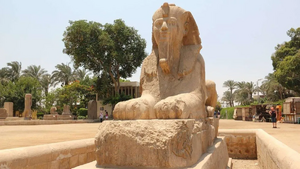
In 1143 BCE, a war between the Amossans and the Calidum Empire was sparked after a Amossan tribe attacked a Calidum fortress at the Battle of Kebeti. By 1138, Calidum forces had been pushed back to Heithalka (Hidalgo) where the city was sieged and after which it was abandoned. The region would stay relatively isolated from the rest of the Zestoric until the late 4th century BCE when the Pylosan Empire colonized Paqueonia. Pylosan colonisation also saw the first use of the name Pakwone was used which derived the name "Paqueonia" and was what the Pylosans labeled the region as. From the late 4th century until the demise of the Pylosan Empire after the 2nd Zestoric War in 1 CE, Pylosan colonies in Paqueonia faced numerous attacks brought by Amossan and later Norravan tribes. Although about 190 settlements had been destroyed throughout the 4 centuries, Pylos managed to maintain a small military presence in the region.
After the 2nd Zestoric War ended in 1 CE, Pylosan colonies especially those on the Hesterlon Peninsula were assimilated into the Alarican Empire. However, Alarican control over the region suffered a setback in 3 CE when a rebellion began in the south. The Farovans of Paloa and remnants of the Pylosan army under the leadership of Glycon, a former Pylosan general, fought for control over the southern peninsula, forming a successful alliance with the Norravans and Aossans. Alarico sent numerous legions and its best generals to the region to quell the rebellion, in 10 CE, Glycon was killed at the Battle of Aima Hill near Tavares resulting in a power struggle among Glycon's allies allowing Alarico to put an end to the rebellion in 11 CE. Following multiple conquests and campaigns during the 1st century and early 2nd century, Alarico was able to assimilate the rest of the Hesterlon Peninsula after destroying a united Cycont army at the Battle of Arouthinium in 129.
Alarican rule and Early Middle Era
A colonial regime was installed in what is now Paqueonia and Paloa soon after the defeat of the Cycont army in 129. They retained control of it for over four centuries. Alarican rule was bound together by law, language, and the Alarican roads. The cultures of the pre-Alarican populations were gradually Alaricanised at different rates depending on what part of the peninsula they lived in, with local leaders being admitted into the Alarican aristocratic class. Hestorlia served as a granary for the Alarican market, and its harbours exported gold, wool, olive oil, and wine. Hafanism was introduced during the mid 2nd century CE and became popular in the cities during the 3rd century. Most of Paqueonia's present languages and religion, and the basis of its laws, originate from this period.
During the late 5th century CE, rebellions became more frequent in the region. According to the Contemporary historian Oppius, following a successful rebellion which occurred in Paloa c. 466, the Hestando people rebelled against Alarico in 470 CE eventually uprooting the colonial regime over Paqueonia in 479 after the Siege of Heithalka ended in a rebellion victory.
In replacement of the power vacuum that manifested with the fall of the Alarican Empire in the Hesterlon Peninsula, the Kingdom of Norab was established in modern day Santo Vaz, in Paloa. It formally replaced Alarico as the main power in the region when king Romeric signed a peace treaty in 504 CE with the Cyconts to the north of the kingdom, allowing them free reign of the north while Norab dominated the south. When Romeric died in 563, the kingdom was divided by Romeric's two sons: Alfredo and Filipe; both of them ruling simultaneously from 563 to 585, the year in which Parauno reunified the kingdom. From 589, he attempted to unite the Hesterlon Peninsula until his death in 614 after which the kingdom dissolved to numerous kingdoms and city-states. At its height in 608, Parauno's kingdom occupied a territory of about 540,000 km2 (208,495 sq mi).
In the north of the peninsula, the collapse of Alarico saw the emergence of long, drawn-out tribal wars between the Cyconts and Aeroans for the greater half of the 6th century. In 587, the Aero Kingdom was established at the newly founded city of Aeron (present day Aarono) under Lucian I. During this time period, major cities such as Haoẽnsia, Brunada, and Auesca were founded. Additionally, an early form of north Paqueon architecture was developed during this period of Paqueon history.
In 766, the Dardonan Empire invaded the Hesterlon Peninsula from Alarico with an army of roughly 9,000 men led by the emperor Alexius I. The army landed on the southern coast near Tavares in Paloa and won the Battle of Tahu against Joham, ruler of the Kingdom of Aavalo, securing a Dardonan beachhead on the peninsula. By 769, Alexius conquered much of the southern and eastern coast and controlled most territory south of the Leitao River. However, he sustained severe injuries during the Battle of Laton in Memesa of 770 after which he succumbed to his injuries. His son, Marcian II took his father's role as ruler in Marto the same year. The Battle of Aroun in 774 marked the end of the Darodan conquest of the Hesterlon Peninsula which saw the death of Alvoro, the leader of the Kingdom of Aroutho. By 778, the Hesterlon Peninsula was fully intergrated into the empire as three provinces: Hestanda, Pallas, and Xamida.
During the period of Dardonan control, Paqueon culture flourished and the first instance of the Paqueon language began around the late 810s. In addition, Paqueon traditions, holidays and most of their architectural design dates back to this time period. Encouraged by the central government, large structures and monuments were constructed, most of which survives to this day some structures include the Estatua de la Libertad (Statue of Freedom), Abadía de Aarón (Aaron Abbey), Centro Hestanda, etc.
Paqueon Revolution

Under the reign of the Dardonan emperor Marcian IV, Emperor of Dardona, the Hestando people lived oppressed by the government. the source the racial oppression is often credited by historians to the Memesa attack of 1051 when a group of Hestandans made an attempt of Marcian's life which failed, giving Marcian IV a reason to supress them. Tired of the oppression, a former Hestandan Petty Officer by the name of Francisco Aleix raised a group of Hestandan Milita known as Pakueon Libre (Free Pakueon) and rebelled against the empire. Although the date of beginning for the rebellion depends from place to place, the generally accepted date by scholars today is 17 Kunnen 1059 which later became the national day for Paqueonia.
By early spring of 1060, the rebellion had more than 20,000 militiamen fighting against the Dardonans. In Enero of 1061, Francisco's milita preformed an attack on Castelano and managed to capture the city after a bloody and pyrrhic victory. Despite the heavy loses, the victory gave the rebels a place that could act as a headquarter which they did. However from 1061 onwards, the conflict gradually soured for the rebellion, and the Dardonan Army prevailed. Eventually in 1073, Francisco was killed in action after the Battle of Aaron near present day Aarono. His son, Alvaro Aleix replaced him as leader of the rebellion. Alvaro managed to score minor victories against the Dardonans such as the Battle of Haora Fields or Aroko. However, the tides of the conflict fully changed into the rebellion's favor in 1089 with the Battle of Hidalgo which saw them securing the city, restricting Dardonan supplies and reinforcements from easily entering the Hesterlon Peninsula.
Alvaro siezed the chance to destroy the Dardonan army in Paqueonia and allowed one of his friend Guillem Ferrón to attack the city of Brunada which held about 12,000 Dardonan soldiers, the largest concentration of soldiers in the conflict. The Siege of Brunada as the attack was called, lasted for 5 months from 19 Pulungana 1089 to the 25 Pusper 1090 and ended in a rebellion victory. the last few years of the conflict was characterised by skirmishes between what remained of the Dardonan army and the Hestandan milita. On the 24 Okjatab 1092, the Treaty of Duran was agreed upon, seeing a formal end to the conflict and the establishment of the Kingdom of Paqueonia with Alvaro I as king.
Early kingdom and the Paqueon-Hesserlic union
The establishment of Paqueonia saw the beginning of the Paqueon Cultural Golden Age which, starting from the early 12th century saw literature, music, philosophy and other aspects of culture flourish in Paqueonia, based on Hestandan and Alarican traditions. An important philosopher from this time is Jorge Halconero. Alarican law and its institutions were the model for the legislators. During the 1110s-1130s, Alvaro I and his successor Alvaro II focused on strengthening this Hestandan and Alarican past, and also began relations with multiple Oranish nations.
The first wave of Great Plague from 1139 to 1161 marked the end of the Paqueon Cultural Golden Age as well as devastating the population of the country. The Great Plague stuck Paqueonia again from 1173 to 1212, and for the last time from 1235 to 1267. In 1142, the Mutamni Purge spread from Cavala, resulting in the deaths and deportation of approximately 97,000 Mutamniers before Afonso III ended it in 1173 with the Carta de la Magia which outlawed the persecution of Mutamniers among other things. In addition, The Terranist Genocide decimated the Terranist population.
During Paqueonia's participation of the Oranland War from 1299 to 1310, they were pushed out of modern day Cavala by an alliance of Runburgian, Seridan, and Ivaburgian aligned principalities known as the Gestirn League. After the conflict, the Veragese Collective proceeded to annex all Paqueon territory to the north of the Surmonté mountains.
In 1327, the royal line of Paqueonia ended with the death of Jorge I. As a result, the Cambier Treaty gave the Crown to Sofia I (niece of Jorge I) who so happened to also be the ruler of the Empire of the Hesserlic alongside Andrea II, Emperor of the Paqueon-Hesserlia which saw the beginning of a personal union between the Hesserlic and Paqueonia.
During the early period of Paqueon-Hesserlic Union, Paqueonia saw the rise of more anti-Terranist sentiment among both the upper and lower-class population. There were mass killings across Paqueonia during the late 1320s and the 1330s, with an estimate of roughly 42,000 Terranists killed by the end of the 1330s. Women and children were sold into slavery, and many Terranist churches were burned to the ground. This eventually culminated in the beginning of the Ofencian Rebellion in Pusper of 1339, in which the famous Battle of Puente Ravolda occurred in 1342 when 200 pro-Terranist men fought against a Paqueon army of roughly 3,400 men and won. Considered in Paqueonia as one of the deadliest war besides the Oranland and Great War, roughly 700,000 people died from the beginning of the war to its end. The conflict ended in 1351 when Andrea II routed the last Ofencian army on the 23rd of Gunyana.
Paqueonia's personal union with the Hesserlic ended in 1412 with the outbreak of the Hesserlic Civil War in Hesserlia. During the war, Paqueon soldiers were enlisted and were sent to fight in Hesserlia. These soldiers would later make up what is now known as the Legión Extranjera Paqueaño (Paqueon Foreign Legion). The war ended in Disemba of 1419 with the establishment of the Union of Hesserlia.
The early and mid 15th century was marked by religious and cultural turmoil both politically and apolitically. However, a centralisation of royal power ensued during this period at the expense of local nobility, and the name 'Paqueañes' and its demonyms began to be commonly used among the people. In 1447, Jorge II introduced a wide-range of political, legal, religious, and military reforms which have been described by modern historians as 'ahead of its time'. These reforms later paved the way to the emergence of the Paqueon Empire during the early 16th century.
During the late 15th century, two rebellions occurred, first a Mutamni uprising known as the Heshiso Uprising of 1458 from 1458 to 1465, and a Terranist one called the Inteminan Rebellion from 1471 to 1475.
Paqueon Empire
Although sailing was quite prominent in Paqueon culture before the 16th century, it was bolstered with the invention of the Enbarck by Palon engineer Quim Vaza.
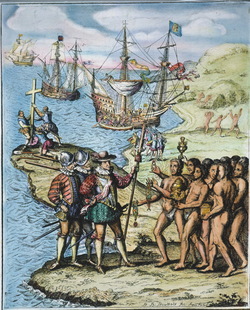
Although stories and rumours of a landmass to the west of Oranath and Naphtora persisted throughout the eras they were never confirmed and remained widely a myth throughout the Ancient to Middle Eras. However, on 13 Pusper 1513 Paqueon explorer, Kuno Schenck embarked on a voyage funded by the Paqueon monarch with a fleet of 4 ships. 41 days later on the 24 Kunnen Schenck made landfall on the island of X in modern-day Flakony. Schenck's first voyage across the Ingentric Ocean proved the existence of the Domicas, beginning Oranish exploration and conquest of the region with the first colony set up by Paqueonia in 1515 known as New Castelano in what is at present the nation of La Munda. The founding of the first colony is regarded by many people as the beginning of the Paqueon Empire.
In Flonesia, Paqueon explorer Mateo Lago landed in southern Aralona in Pulungana of 1530, claiming the territory of what is now the city of Damien although no attempts to settle the area were made until 1542. Colonisation in the Domicas was marked by the expansion into central Domica and numerous conflicts with the Atontec Empire and Paloa, the most notable example being the Colonian War (1542-1547) against the Atontecs and the Poder War (1561-1562). Meanwhile, in Aralona, the Flonesian Scramble culminated in the outbreak of the Flonesian War resulting in Paqueonia and Seronia-Sotha's seizing of Palon and Omaran colonies in Aralona by its end in 1586.
The late 16th century and the early 17th century are characterised by the colonisation of modern-day Wavantine and Lavinia which ended with the exploration and the complete colonisation of South Domica by the beginning of the 1640s. Throughout the 17th and 18th centuries, Paqueonia proved to be one of the leading world powers, a position reinforced by trade and wealth from colonial possessions and became Gentu's leading maritime power. This period saw the War of 1602 (1602-1615) between Paqueonia and Neragon throughout their holdings in Gentu, the War of Paqueon Terranity (1620-1625) between the Paqueon Altenic and Paxist churches, the First Atontec War (1654-1666) in South Domica, the First Northern War (1710-1716) in northern Hesterath, and the Lavinian Revolt (1727-1729) carried out by the Lavinians in South Domica.
During the mid-18th century, with the rise of the Slave Network, Paqueonia established multiple slave routes across western Naphtora, beginning Paqueonia's interest in the Naphtoran coast. From 1750 to 1812, Paqueonia invaded and conquered numerous Naphtoran kingdoms along the west Naphtoran coast to secure their supply of slaves. This culminated in the West Naphtoran War against Paloa, a competitor in the region in 1759. They won the war after seven years of conflict, resulting in the establishment of the Colonies of Karaterra and New Parkowo in western Naphtora, two port cities built specifically to house slaves.
In 1748, the Second Atontec War began in South Domica between the Atontecs and the South Atontec Republic. Taking advantage of this, the Paqueon South Domican colonial government in Lavinia and La Munda moved their forces into the Atontec and even signed the Furmdura Agreement (1749) with the Southern Atontecs, establishing an alliance between the nations. Raging from 1748 to 1764, it is regarded by many historians as the most devastating and deadliest war in South Domica. By its end, it had claimed a total of roughly 7 million lives on both sides and concluded with the climactic Battle of El Rojo where the La Munda Paqueon army was routed from northern Atontec territories. This was seen by many as the beginning of the decline of the Paqueon Empire and the first major defeat for Paqueonia since the Hesserlic Civil War in the 1410s.
With the dawn of the Industrial Revolution, factories sprung up throughout the Paqueon countryside resulting in the growth of villages into large cities such as Haoẽnsia, Brunada, Ferron and Auesca. During this period, the population of Paqueonia rose from 9 million in 1760 to nearly double that at 17 million by the mid-19th century.
During the Cavalan Revolution and later the Great Coalition War, the Paqueon Foreign Legion was sent to aid the Veragese Collective against the Cavalans, however, they were mostly destroyed during the Battle of Ôter-Colline in 1819. Meanwhile, in South Domica, the Amplan Wars began with numerous uprisings occurring, the most famous of which was Ureña's Revolution in 1820 in Lavinia led by revolutionary Thiago Ureña, establishing the shortlived Urenian Republic in Phupu that year before it subsequently dissolved into Lavinia and Adinaza just two months later. Other revolutions also occurred in Mavantine, Central Domica, the Nortian Islands, and La Munda.
TBA
Great War
TBA
Contemporary Age
TBA
Geography
With an area of 616,777 km2 (238,139 sq mi) of which 0.52% is water, Paqueonia is Gentu's X largest country and Oranland's X largest country. Mount Maderoja is the highest mountain peak in Paqueonia, its highest point being 2,249 metres above sea level, the 8th highest in Oranland. Paqueonia is a transcontinental country, having territory in both Oranland and North Domica. On the west, Paqueonia is bordered by Paloa; to the south and east, it is bordered by the Zestoric Sea. To the north, along the Surmonté mountains, it is bordered by Cavala.
The majority of Paqueonia's geography consists mainly of flat plains and rolling hills to the south most of which could be found in Antigua. While the north is dominated by highland plateaus disected by mountain ranges. Other landforms include narrow coastal plains and some lowland river valleys, the most prominent of which is the river Gayosa in the southwest. The country can be divided into 4 geographic regions, the Erolonan plateau, Meridional Plains, Gayosa Basin, and the Eastern Coast.
Mountains and rivers
TBA
Climate
TBA
Fauna and Flora
TBA
Politics
Government
Paqueonia is a unitary absolute monarchy, with a hereditary monarch. The head of state is the monarch, currently King Gerado II, who ascended to the throne in 1963 after the death of his father King Carlos V in 1963 and a period of regency. According to the country's constitution, the king is a symbol of unity and the eternity of the Paqueon Kingdom. The heir to the throne, also known as the Crown Prince acts as a secondary leader of Paqueonia. The current Crown Prince is Fidel-Osvaldo, the son of Gerado who aquired his position in 1983 at the age of 18.
The king also appoints the Chief Justice from the legislature and also appoints a minority of legislators to the National Council of Paqueonia with help from an advisory council. The king is allowed by the constitution to appoint some members to the National Council to represent special interests. These special interests are citizens who might have been electoral candidates who were not elected, or might not have stood as candidates. This is done to balance views in the National Council. Special interests could be people of particular gender or race, people of disability, the business community, civic society, and scholars.
The unicameral National Council, consists of 60 seats; 50 members are elected by popular vote while 10 are appointed by the monarch, all of which serve five-year terms. The elections are held every five years after. The last elections were held on the 10 Pulungana 1997. The balloting is done in a non-partisan manner. All election procedures are overseen by the Elections and Boundaries Commission.
Foreign relations
TBA
Military
TBA
Human rights
TBA
Administrative division
The Paqueon Kingdom is divided into 5 regions and 2 autonomous cities. The 5 regions are divided into 16 provinces which are subdivided into municipalities of which there are 63 of. In turn, the municipalities are divided into 319 civil parishes. Operationally, the municipality, autonomous city and civil parish, along with the national government, are the only legally local administrative units identified by the government of Paqueonia (for example, cities, towns or villages have no standing in law, although may be used as catchment for the defining services).
the 5 regions that make up Paqueonia are: Antigua, Parkowo, Casoloria, Erolona, and Desiria. The 16 provinces are: Kalbanca, Aarona, Brunada, Haoẽnsida, Latoncia, Haobrils, Ferron, Arokoño, Alvara, Norravia, Surdosa, Izquierdad, Pueblona, Azulencia, Grisville, and Vitorao. While the 2 autonomous cities of Paqueonia are Castelano, and Hidalgo.
| Regions | ||||||||
|---|---|---|---|---|---|---|---|---|
| Region | Flag | Population (1996) | 
| |||||
| 1 | Antigua | 12,890,000 | ||||||
| 2 | Parkowo | 17,583,300 | ||||||
| 3 | Casoloria | 5,679,000 | ||||||
| 4 | Erolona | 9,103,900 | ||||||
| 5 | Desiria | 8,234,000 | ||||||
Economy
TBA
Aerospace industry
TBA
Agriculture
TBA
Tourism
TBA
Energy
TBA
Transport
TBA
Science and technology
TBA
Demographics
TBA
Major cities
TBA
Peoples
TBA
Languages
TBA
Education
TBA
Health
TBA
Religion
TBA
Culture
TBA
Gekso sites
TBA
Literature
TBA
Philosophy
TBA
Art
TBA
Cinema
TBA
Architecture
TBA
Music and dance
TBA
Cuisine
TBA
Sport
TBA
Holidays and festivals
TBA



